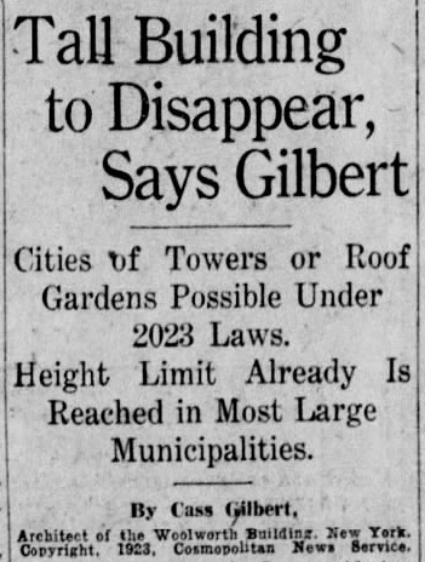© Mark Ollig
On Jan. 1, 1923, the front page of The Minnesota Daily Star newspaper printed “2-0-2-3” in bold typeset.
Underneath were the italicized words, “It is interesting to note what eminent men and woman visualize for 2023 in their respective sphere, should they awake, Rip Van Winkle like, in that year.”
On Jan. 7, 1923, the Minneapolis Sunday Tribune contained an article by Cass Gilbert, the architect of the Woolworth Building in New York, forecasting city architecture in 2023.
“I believe that buildings in the future, except in more congested parts of large cities, may be of less height than those of today. We may, as the result of certain laws, have cities of towers or of terraces and roof gardens,” Gilbert wrote.
In 1923, the tallest building in the US (and the world) was the Woolworth Building in New York, at 792 ft.
Today, One World Trade Center in New York is the tallest building in the US at 1,776 ft, symbolizing the country’s independence in 1776. Its observation deck height is 1,266 ft.
On Jan. 2, 1923, the Minneapolis Morning Tribune printed predictions for 2023 from Major General Edward F. McGlachlin, of the United States Army War College, who said, “There will still be wars in the twenty-first century.”
He added, “There will be wars when fear reaches the limit of endurance, and we will become engaged when our existence, our interests, our pride, or our ideals are sufficiently at stake.”
McGlachlin anticipated, “huge tanks that can go underseas, submersibles that can fly, are not beyond the possibility before 2023.”
He also forecasted that “communication by radio may be secret and direct over vast distances, as though one whispered to a friend. The helicopter may raise airplanes vertically. Helium may make balloons safe. Aerial photographs may be transmitted by radio. Land survey from great heights may be accurate.”
Today, an estimated 1,000 US classified military intelligence-gathering satellites orbit the Earth. Many are used for accurate reconnaissance “land survey from great heights” photography transmitted via encrypted radio signals to US government military facilities.
Currently, the largest US submarine is the Ohio class of nuclear-powered subs; it is 560 ft long, with its four-deck sections being 42 ft in diameter. Its gross weight is 37.5 million pounds.
Presently, the US military has the Bell Boeing V-22, Osprey, a vertical takeoff and landing capable aircraft using propeller blade rotors like a conventional helicopter.
This year, the Department of Defense will deploy helium-filled balloons to monitor US skies 24 hours a day as part of JLENS (Joint Land Attack Cruise Missile Defense Elevated Netted Sensor System).
On Jan. 2, 1923, the front-page headline of the California Colton Courier newspaper read, “Planes will fill the sky in 2023.”
“The people living in the United States in 2023 will look up and see the sky filled with different types of aviation craft flying along well-laid-out and controlled routes or highways. Hundreds, if not thousands, of aircraft will be in use,” the newspaper wrote just 20 years after Orville and Wilbur Wright flew their first airplane.
Today’s skies are filled with an average of 9,700 aviation craft flying along well-laid-out and controlled routes or highways.
In 1923, Schick manufactured the first electric shaver, Frigidaire introduced the refrigerator, and Clarence Birdseye began selling frozen foods.
The same year, RCA was manufacturing the Radioloa IV, a self-contained wood cabinet radio receiver featuring a built-in speaker.
William Kerridge Haselden’s futuristic cartoon, first drawn in 1919, was republished by London’s The Daily Mirror newspaper Jan. 23, 1923, with the title “The Pocket Telephone: When Will it Ring?”
The cartoon illustrated how having a small pocket telephone would cause embarrassing interruptions when it rings at a concert, a baby’s baptism, or a wedding, and frustration while running for a train, holding items with both hands, or walking in the rain with an umbrella.
“We shall certainly be rung up at the most awkward moments in our daily lives,” says the cartoon caption.
Today, one hundred years later, we adjust our “pocket phone” ring volume, or set its mode to silent or vibrate. What would Mr. Haselden have thought about that?
By 2123, some four generations from now, technology will have advanced significantly. Those living then will be using ultra-smart devices that would seem magical to those of us today.
One hundred years from now, people will interact with semi-sentient devices linked through a post-quantum quark-scale hierarchical computing network employing advanced algorithms – or something like that.
Of course, the big question all of us would want to ask of those living in 2123 is, “Do people travel around in flying cars?”

